All About Aurorae, the Moon Passes Planets and Occults a Teapot Star Before Growing Harvest Full!
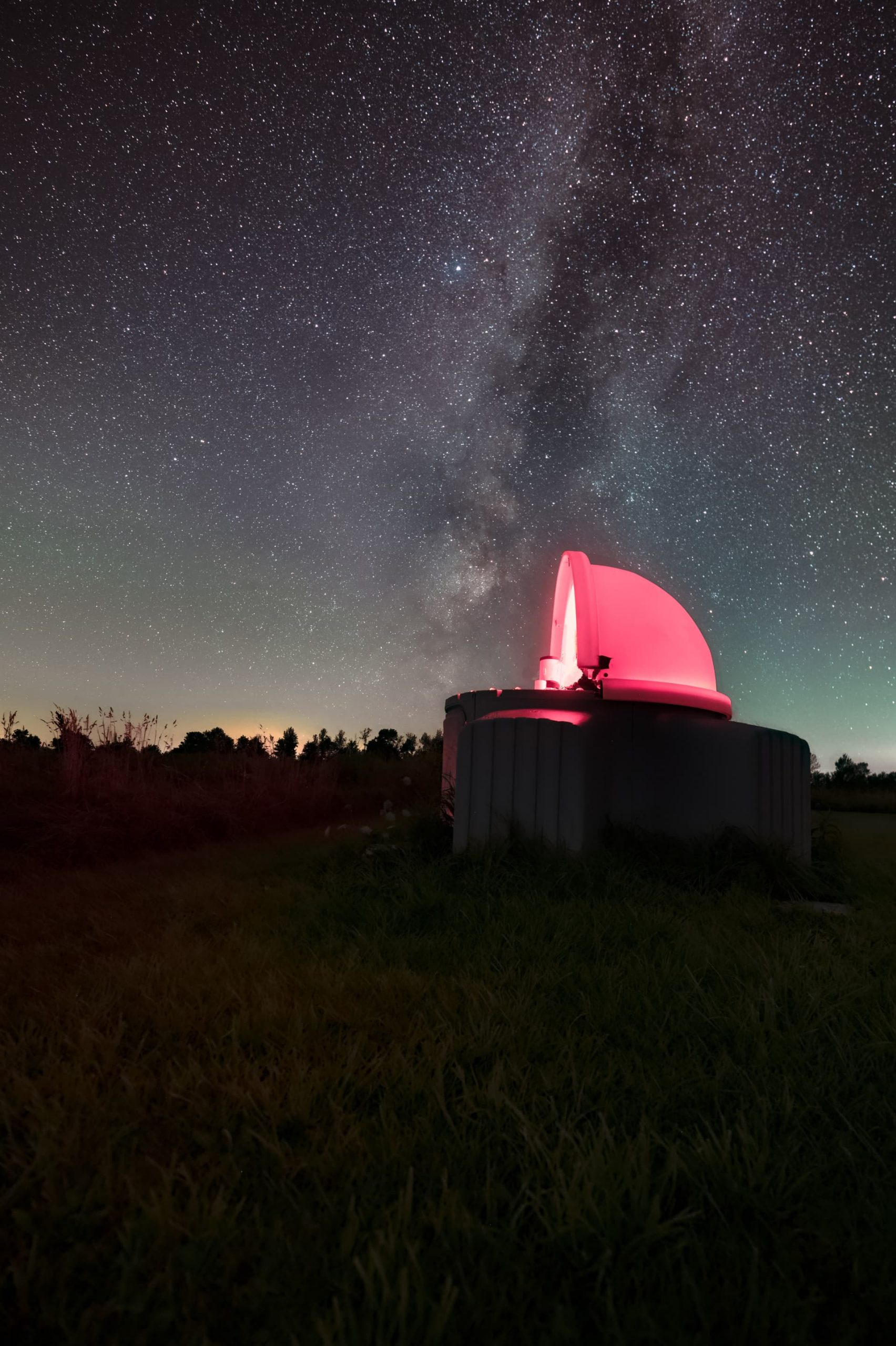
This terrific image of the summer Milky Way rising from the southern sky, was captured on the moonless weekend of August 27, 2022 by Manu Mukerji while at the Carr Astronomical Observatory operated by the RASC Toronto Centre northwest of Toronto. In the foreground is a SkyShed Pod, a favorite of serious amateur astronomers who want to set their telescope up permanently.
Hello, September Stargazers!
Here are your Astronomy Skylights for the week of September 4th, 2022 by Chris Vaughan. Feel free to pass this along to your friends and send me your comments, questions, and suggested topics. I repost these emails with photos at http://astrogeo.ca/skylights/ where the old editions are archived. You can also follow me on Twitter as @astrogeoguy! Unless otherwise noted, all times are expressed in Eastern Time. To subscribe to these emails please click this MailChimp link.
If you’d like me to bring my Digital Starlab portable inflatable planetarium to your school or other daytime or evening event, or deliver a session online, contact me through AstroGeo.ca, and we’ll tour the Universe, or the Earth’s interior, together! My terrific new book with John A. Read entitled 110 Things to See With a Telescope is a guide to viewing the deep sky objects in the Messier List – for both beginners and seasoned astronomers. DM me to order a signed copy!
The sun has been triggering more auroral displays recently, so I explain all about them. The moon will shine brightly in evening skies worldwide this week as it waxes to the Full Harvest Moon. Along the way it will pass evening planets and occult a bright star. Read on for your Skylights!
Aurorae Alert!
You may have noticed that images and videos of the Northern Lights, technically the aurora borealis, have been popping up more on social media recently. That’s because night mode on our smartphone cameras has been getting better, and because the sun, the source for those night-time displays, has “woken up” after a number of years of quiescence. The accounts of sky-watchers and astro-imagers living in the Canadian prairies are filled with them! Let’s look at the physics and astronomy behind those glorious displays, part of what astronomers call “space weather”.
The intense fusion reactions inside the sun and the flow of ionized particles (mainly Hydrogen atoms split into their components of one proton and one electron) combine to give the sun an intense magnetic field. Since the sun is a sphere of compressed gases, and not a solid ball like Earth, its rotation is differential. A point on the sun’s equator will circle the star once in 24.47 Earth days, but a point close to its northern or southern pole will take almost 38 days! The sun’s average rotation period of 28 days closely matches our moon’s orbital period – but that’s a mere coincidence of nature.
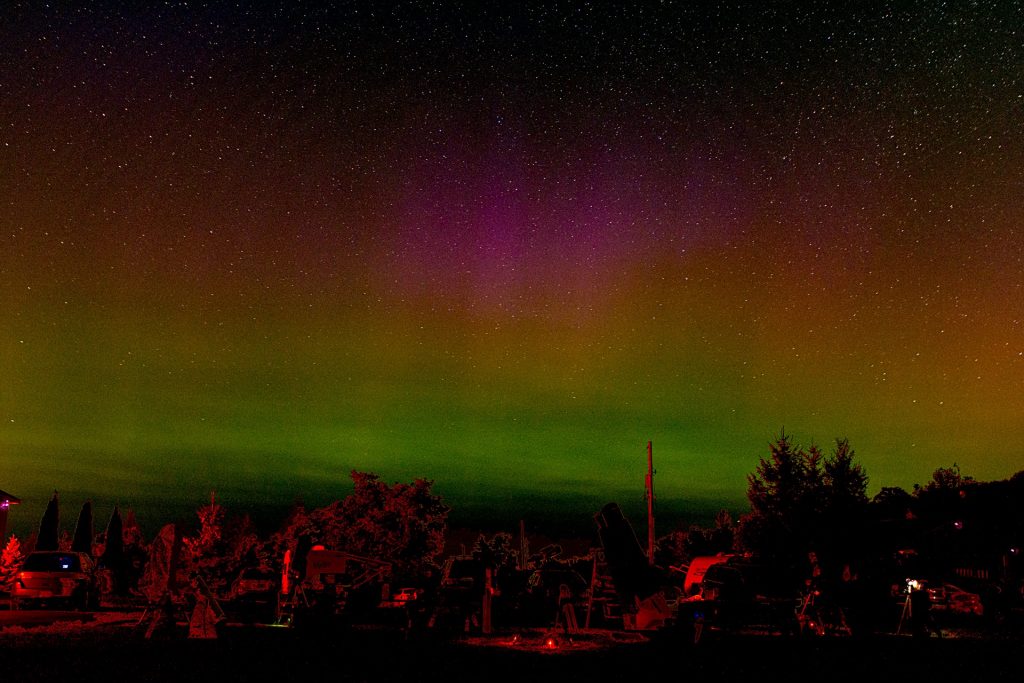
The differential rotation causes the sun’s global magnetic field to wind up tighter over time. Magnetic fields can’t merge or cross one another. (That’s why it’s difficult to push the same poles of two magnets together.) As the sun’s field tightens up, small regions within it develop tangles of magnetism that prevent the heat beneath them from flowing out of the sun. Those cooler areas are visible from Earth as sunspots. Astronomers formally call them active regions, and number them.
Sunspots can develop, grow, and fade within hours and days – or persist for weeks. Viewed from Earth, they take about two weeks to cross the sun’s disk – allowing us time to see them evolve. Scientists have also placed satellites on the far side of the sun to watch the solar hemisphere that we can’t see. That’s because, from time to time, the buildup of energy in those tangles gets violently released as solar flares, and as eruptions of charged matter into space called coronal mass ejections (or CME’s for short). Those events, which happen in minutes, cause the auroras at Earth’s polar regions to grow stronger. They also endanger orbiting astronauts and satellites with intense radiation – if Earth happens to be in the line of fire. The flares vary in intensity. They are ranked by class, from weak A-class to extreme M- and X-class. During a flare, the sun’s magnetic field lines are snapping and re-connecting into simpler configurations.

Over a period of time, more and more spots appear, and more and more violent events occur. Eventually, the sun sheds its excess energy, the magnetic fields smooth out, and the sun settles into a quiet period with no, or very few, sunspots and flares. Astronomers have been able to view the sun through filters, count the sunspots, and record their number in a log. It turns out that the sun needs about 11 Earth-years to build up and then wind down. Even more interestingly, the polarity of the magnetic field reverses with each sunspot cycle, producing a 22-year period between true cycles. There are lots of online sources showing graphs of the counts, including this page of recent ones and this one. At the far right end of the graph you can see how the sunspot number has recently been climbing over time.
The name Aurora Borealis, Latin for northern lights, was coined by Galileo in 1619. (Aurora was the Roman goddess of the dawn.) He did not know then that there were also Aurora Australis visible at southern latitudes. The aurorae work in a similar way to neon lights and fluorescent tubes. If you add energy to certain gases, their outer-shell electrons absorb the energy by jumping to a higher state. Since they don’t like to stay there, they relax and shed the energy as a photon of light at a specific wavelength (or colour) of light.
If the clouds of energetic particles produced by CMEs reach Earth – most of them miss us – they are stopped and deflected towards our north and south magnetic poles by the Earth’s protective magnetic field, which has a distorted apple-shape. The field’s outer “skin” extends well above our atmosphere, into space. But the magnetic field drops lower and penetrates the Earth’s surface at our northern and southern magnetic pole – the way the apple’s skin pinches inwards towards its core at top and bottom.
The sun-facing side of the Earth’s field is pushed somewhat towards the Earth’s surface (flattened) by the pressure of the Sun’s constant solar wind. The side pointing away from the Sun is pulled further away from the Earth’s surface and forms an elongated “tail”. (The whole system resembles a drop of water with a rounded nose and pointed rear). The shape of our field always keeps the elongated “tail” facing away from the Sun while the Earth rotates inside of it.
When the deflected charged particles from the Sun become channeled down into the pinched areas near Earth’s poles, they gain intensity and come in contact with atoms and molecules comprising our atmosphere, causing those gases to glow! Yellow-green colours are oxygen molecules emitting 557.5 nanometre light about 100-300 km above the ground. Human eyes are tuned to this colour range. The concentration of atomic oxygen drops off below 100 km.
Blues, pinks and dark red arise from nitrogen atom lines between 391 and 470 nm, about 100 km up. Reds lines at 630 and 636 nm occasionally arise from more strongly ionized oxygen atoms above 300 km. Nitrogen molecules produce 428 nm blues and some magentas, which are harder for human eyes to detect. The other colours we see arise from the blending of red and blue to make pink, yellow, etc.

The shimmering and colour changes that we see in auroral displays occur as the intensity of the solar material and the density of our atmosphere varies – just like wind on a breezy day moves some branches, then others, then none at all.
The aurorae actually form lopsided rings surrounding each of Earth’s magnetic poles. (Jupiter and Saturn have auroral rings, too.) When the solar particles are less energetic, they need to be concentrated more to produce the glow, so the auroral ring becomes smaller and hugs the magnetic pole (i.e., farther north). When the Sun emits a strong burst of energy our way, the ring expands much farther from the poles – allowing us to see aurorae at lower latitudes!
The nights around the March and September equinoxes offer a higher likelihood of aurorae. Just as two bar magnets lined up with their poles in the same direction repel one another strongly, the Earth’s magnetic field repels the sun’s field. At the equinoxes, the Earth’s axis tilts partly sideways compared to the sun, so the two “magnets” aren’t lined up as well, reducing Earth’s ability to deflect the sun’s field and the charged particles that trigger aurorae in our upper atmosphere.
Scientists can alert us when the chance of aurorae is higher because solar observing satellites can detect an increase in the Sun’s output immediately, but the energetic particles take several days to arrive at Earth. The website www.spaceweather.com provides a measurement called the Kp Index and a map of the current aurora ring position for North America. Scroll down on the left side of the page. Remember that as the Earth turns, various longitudes take turns being under the ring. The trick is to be there while the sky is both dark and clear!
You can sign up for email alerts at Spaceweather.com, follow @SpaceWeatherCA (and other accounts) on Twitter, or install one of the many space weather apps on your phone.
I hosted an Insider’s Guide to the Galaxy program about aurorae, with special guest expert Alan Dyer (on Twitter as @amazingskyguy), in March, 2021. To have the best chance to see the aurorae, wait for an alert, then find a dark sky (preferably moonless) and watch towards your nearest magnetic pole – north or south. If you suspect aurorae are there, but faint, try taking some long exposures with your camera on a tripod pointing north. Even a 5 or 10 second exposure can reveal colours that your eyes can’t detect! For the sure thing, one can book a trip to northern Canada or Scandinavia. Good luck!
The Moon
After Saturday’s first quarter moon phase, our natural nightlight will spend this week waxing toward the full harvest moon, filling evening skies around the world with bright moonlight. Today (Sunday) the slightly gibbous waxing moon will rise in late afternoon and then shine after dusk just to the right (or celestial west) of the teapot-shaped stars of Sagittarius (the Archer). They’ll set in the west around midnight. The moon will remain among the stars of Sagittarius until Tuesday night. As I mentioned last week here, those three evenings will be a fine time to see the features of Mare Imbrium enhanced by slanted sunlight as the terminator slides westward across it.
On Monday night the moon will pass in front of, or occult, a bright star in the Teapot’s handle named Namalsadirah or Tau Sagittarii – a sight visible in binoculars and any size of telescope by observers in Mexico and the Caribbean, the continental USA, and most of Canada. (North of Edmonton, the moon will just miss the star. In Vancouver, the occultation will occur in a twilight sky.) Times vary by location, but you can check this list for your city and correct the disappearance Universal Time to your local time. For Toronto, the dark leading edge of the moon will cover the star at 11:43 pm EDT. The star will emerge from behind the bright edge moon beside Mare Crisium at 12:47 am EDT. For best results, start watching a few minutes before each time.
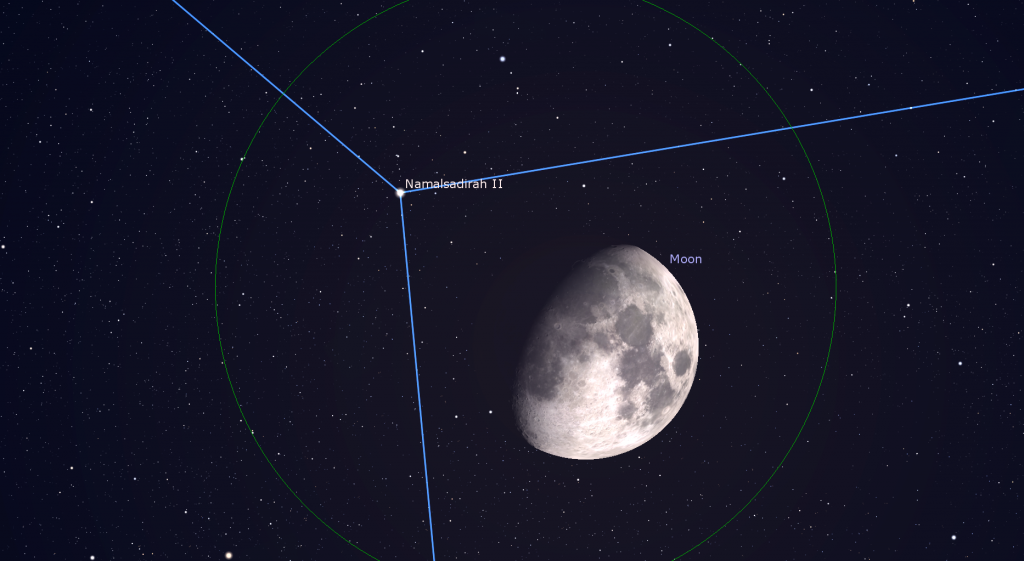
From Wednesday to Thursday, the nearly full moon will traverse the faint stars of Capricornus (the Sea-Goat) as it hops past the yellowish dot of Saturn. On Wednesday, Saturn will be positioned almost a fist’s diameter to the moon’s upper left (celestial southwest). On Thursday, it will be a similar span to the moon’s upper right (celestial east). If you watch the duo over the course of several hours on either night, you’ll detect a slight difference in their relative positions caused by the moon’s orbital motion. It moves by about its own diameter every hour, compared to the background stars and planets.
The very bright moon will spend Friday and Saturday nights crossing Aquarius (the Water-Bearer). At mid-northern latitudes, Friday’s moon will rise at about 8 pm local time. In the Americas, it will then look full to your unaided eyes – but use your binoculars or telescope to see that a very thin strip along the left-hand edge of the moon (its western limb) will still be dark. That’s because the moon will still be hours away from full.
On Saturday morning at 5:59 am EDT (or 09:59 Greenwich Mean Time), the moon will officially reach its full phase, when it will be opposite to the sun in the sky. The September full moon, traditionally known as the “Corn Moon” and “Barley Moon”, always shines in or near the stars of Aquarius and Pisces. The indigenous Anishinaabe people of the Great Lakes region call this moon Waatebagaa-giizis or Waabaagbagaa-giizis, the “Leaves Turning Moon” or “Leaves Falling Moon”. The Cree Nation of central Canada calls the September full moon Nimitahamowipisim, the “Rutting Moon” – when the bull moose scrapes the velvet from his antlers as a sign that mating shall begin. The Haudenosaunee (Iroquois) of Eastern North America call it Seskehko-wa, the “Time of Much Freshness Moon”.

Because this is the full moon occurring closest to the autumnal equinox in 2022, it is also the harvest moon. On the evenings around its full phase, the moon normally rises about 50 minutes later than the previous night. But around the equinox the shallow slope of the evening ecliptic (and the moon’s orbit) causes harvest moons to rise at almost the same time each night – only delayed by as little as 10 minutes, depending on your latitude. For Toronto latitudes, the delay is about 20 minutes.
The harvest moon phenomenon traditionally allowed farmers to work into the evening under bright moonlight – hence its name. It also means that if you arrive home from work, or walk the dog, at the same time every evening, you might notice the “full” moon for several days in a row. The effect is stronger the farther from the equator you live. The moon behaves the same way for Southern Hemisphere dwellers – but six months later, at their own autumnal equinox in March.
With no shadows anywhere, the light and dark areas on the full moon correspond to different rock types on the moon’s surface. The bright areas are the ancient, heavily-cratered lunar highlands composed of crystalline anorthosite rock, and the dark areas are younger maria, iron-rich basalts that have filled the oldest deep basins and which have fewer craters. The nights around full are also the best ones for seeing the bright ray systems surrounding the younger craters on the moon – material that was blasted out during the impact that formed the crater, and by the secondary impacts of the excavated chunks of rock.
A sure sign of autumn is that full moons can be seen rising majestically well before bedtime, whereas the late sunsets of summer reserved the full moon until midnight. If you want to complete one of the moon observing programs offered by the Royal Astronomical society of Canada or the Astronomical League of the USA, don’t use the summer months – unless you want to stay up all night. Do them in spring or autumn.
Saturday night’s full moon will be shining a fist’s diameter to the right of bright Jupiter. Very faint Neptune will be only a few finger widths above the moon, but don’t bother seeking it out. On Sunday, the waning gibbous moon will hop to Jupiter’s lower left among the northernmost stars of Cetus (the Whale).
The Planets
As the sky begins to darken after sunset, the medium-bright, yellowish dot of Saturn will appear in the lower part of the southeastern sky. Since last month, it has been creeping slowly westward in a retrograde loop through the mostly-faint stars of Capricornus (the Sea-Goat). Saturn will cross the sky all night and set in the west-southwest before 5 am local time. Since the planets always look their best in a telescope when they are higher in the sky, Saturn’s peak viewing time will be around midnight, when it will shine in the south. That window will shift earlier by half an hour with each passing week.

Even a small telescope will show Saturn’s subtly banded globe encircled by its rings, which will become more edge-on to us every year until the spring of 2025. This year Saturn’s southern polar region has already extended well beyond the ring plane. See if you can see the Cassini Division, the narrow, dark gap that separates Saturn’s main inner ring from its bright outer one. Over the coming weeks, Saturn’s slide to the west of the anti-solar point will cause the planet’s globe to cast a widening wedge of dark shadow onto the rings where they emerge from behind the eastern limb of the planet. Where you find the shadow will depend on how your telescope flips and/or mirrors the view. In a refractor or SCT telescope, it’s toward the upper right. In a Newtonian reflector, it will be towards lower right. An equatorial mount will also rotate things a little. Take long looks and wait for moments of perfect clarity.
A small telescope can also show several of Saturn’s moons – especially its largest, brightest moon, Titan! From here on Earth, Saturn’s axial tilt of 26.7° lets us see the top of its ring plane, and allows its brighter moons to array themselves all around the planet. Saturn’s largest and brightest moon Titan never wanders more than five times the width of Saturn’s rings from the planet. The much fainter moon named Iapetus can stray up to twelve times the ring width during its 80-day orbit of Saturn. The next brightest moons Rhea, Dione, Tethys, Enceladus, and Mimas all stay within one ring-width of Saturn. During evening this week, Titan will migrate counter-clockwise around Saturn, moving from the upper right (or celestial northwest) the planet tonight (Sunday) to the lower left (or celestial southeast of) the planet next Sunday. (Remember that your telescope might flip that view around.) How many of the moons can you see in your telescope?
This week, extremely bright, white Jupiter will rise above the eastern horizon around 8:30 pm local time, and then spend the night among the modest stars of Pisces (the Fishes), following 17 times fainter Saturn across the sky. Jupiter will climb highest at 2:30 am, but it will look pretty good in any telescope after 10:30 pm local time. Early risers can spot the planet a third of the way up the southwestern sky before sunrise.
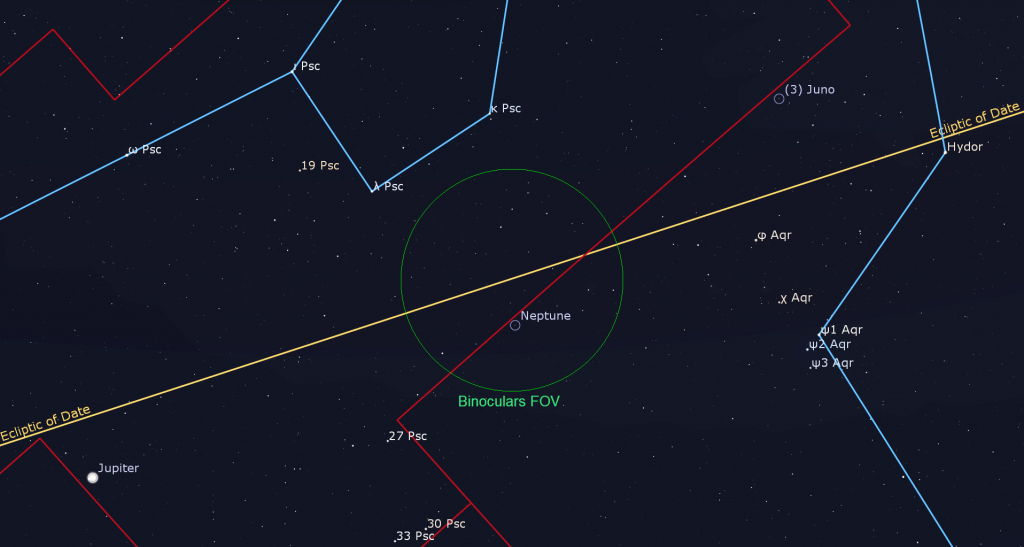
Good binoculars will show Jupiter’s disk flanked by its row of four Galilean moons Io, Europa, Ganymede and Callisto, which complete orbits of the planet every 1.7, 3.6, 7.2, and 16.7 days, respectively. If you see fewer than four of them, then one or more is crossing in front of or behind Jupiter – or lurking in Jupiter’s dark shadow – or two moons are occulting one another. Any size of telescope will show Jupiter’s dark bands running parallel its equator.
Because Jupiter rotates once every 10 Earth hours, we can use a good backyard telescope to watch the pale-looking Great Red Spot cross the planet every 2nd or 3rd night. For observers in the Americas, the GRS will cross Jupiter’s disk on Sunday, Tuesday, Friday, and Sunday evening, and also during the wee hours of Wednesday, Friday, and Sunday morning. The small, black shadows of Jupiter’s Galilean moons are visible through a good backyard telescope when they cross the planet’s disk. Europa’s tiny shadow will cross Jupiter with the Great Red Spot on Tuesday evening from 9:50 pm to 12:20 am EDT. Io’s little shadow will cross on Wednesday from 11:40 pm to 1:45 am EDT.
The medium-bright, reddish dot of Mars will rise above the east-northeastern horizon around 11:20 pm local time and will deliver nice views in a backyard telescope after about 1:30 am local time. In a telescope, Mars will show a tiny, 85%-illuminated disk. Watch for the bright little Pleiades star cluster shining a fist’s diameter above the planet and the bright reddish star Aldebaran a short distance below Mars. Mars will be brightening and growing larger as Earth’s faster orbit draws us closer to it over the coming months. We’re 140 million km (or 7.75 light-minutes) from it this week.
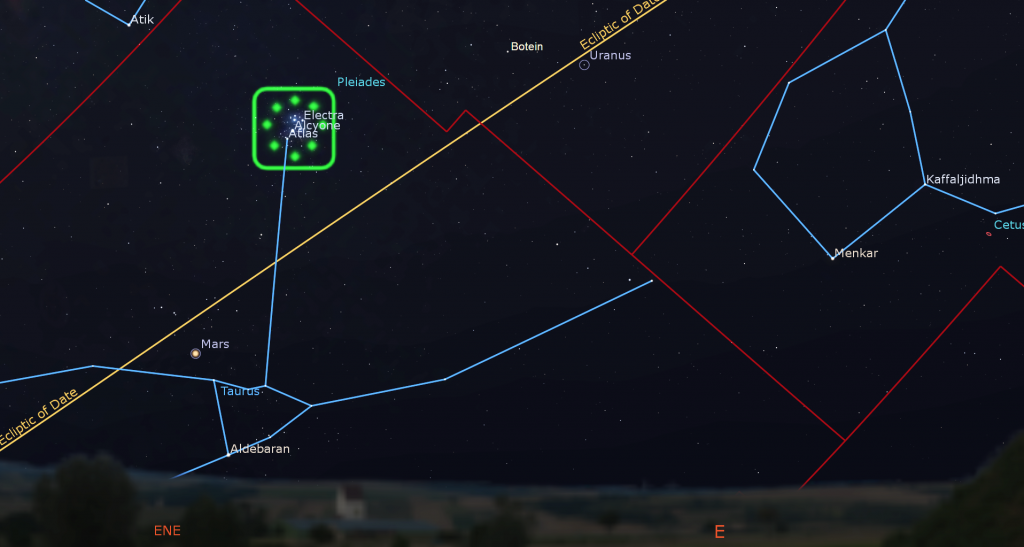
Magnitude 5.7 Uranus will be high enough for telescope-viewing, in the lower part of the eastern sky, after about midnight local time this week. The blue-green speck of the planet is located two fist widths to the upper right (or celestial west) of Mars. Since Mars is speeding away eastward, their separation will grow from 20° to 23° over this week. Without Mars to help you, the brightest guideposts to Uranus are several medium-bright stars named Botein (or Delta Arietis), Al Butain II (or Rho Arietis), and Sigma Arietis which will appear several finger widths from Uranus. Those stars mark the feet of the Ram.
Venus’ sunward swing is making it increasingly harder to catch sight of in the eastern morning sky. The extremely bright planet will be rising just after 5:30 am local time this week, but it won’t climb very high before the coming sunrise brightens the sky around it. Observers in the northern tropics will be able to see Venus until about mid-September. On Monday morning, Venus will pass telescope-close to the bright star Regulus in Leo (the Lion).
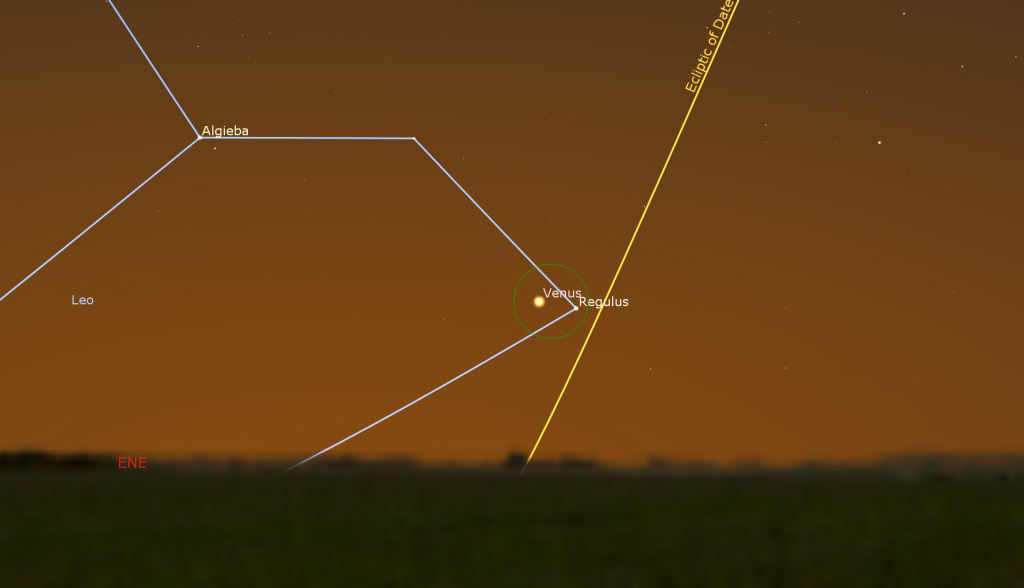
The Northern Crown is in the West
If you missed last week’s tour of the constellation of Corona Borealis (the Northern Crown) I posted it here.
Public Astro-Themed Events
Every Monday evening, York University’s Allan I. Carswell Observatory runs an online star party – broadcasting views from four telescopes/cameras, answering viewer questions, and taking requests! Details are here. They host in-person viewing on the first clear Wednesday night each month. Other Wednesdays they stream views online via the observatory YouTube channel. Details are here.
Taking advantage of the crescent moon in the sky this week, the RASC Toronto Centre astronomers will hold their free monthly City Sky Star Party in Bayview Village Park (steps from the Bayview subway station), starting after dusk on the first clear weeknight this week (Mon to Thu only). Check here for details, and check the banner on their website home page or Facebook page for the GO or NO-GO decision around 5 pm each day.
On Tuesday, September 6 from 7 to 8 pm EDT, the Dunlap Institute at University of Toronto will stream their popular Astro Trivia Night. The live, free event will feature lots of fun and prizes. Details are here.
Weather permitting, on Tuesday, September 6 from 8:30 to 10 pm, astronomers from RASC – Mississauga will hold a public star party at the Riverwood Conservancy, 4300 Riverwood Park Lane, Mississauga. Details and the ticket registration link are here.
On Wednesday evening, September 7 at 7:30 pm EDT, the RASC Toronto Centre will live stream their monthly Recreational Astronomy Night Meeting at https://www.youtube.com/rasctoronto/live. Talks include The Sky This Month and astrophotography talks. Details are here.
On Thursday, September 8 at 7 pm EDT, RASC Mississauga will kick off their 4-part Introductory Astronomy Course held at the Riverwood Conservancy, 4300 Riverwood Park Lane, Mississauga, ON (north off Burnamthorpe between Mississauga Rd and Mavis Rd.). Registration details and more are here.
RASC’s Public sessions at the David Dunlap Observatory may not be running at the moment, but they are pleased to offer some virtual experiences instead in partnership with Richmond Hill. The modest fee supports RASC’s education and public outreach efforts at DDO. Only one registration per household is required. Prior to the start of the program, registrants will be emailed the virtual program link.
On Friday night, September 9 from 8 to 9:30 pm EDT, the DDO Astronomy Speakers Night program will feature Leo Alcom, a postdoctoral fellow at the David A Dunlap Department of Astronomy and Astrophysics. She’ll speak on Blowing Bubbles in Plasma: Galactic Fountains at the Centers of Galaxy Clusters. There will also be a virtual tour of the DDO and live-streamed views from the DDO’s 74-Inch telescope (weather permitting). The deadline to register for this program is Wednesday, September 7, 2022 at 3 pm. More information is here and the registration link is here.
On Sunday afternoon, September 11 from 12:30 to 1 pm EDT, tune in for DDO Sunday Sungazing. Safely observe the sun with RASC, from the comfort of your home! During these family-friendly sessions, a DDO Astronomer will answer your questions about our closest star: the sun! Learn how the sun works and how it affects our home planet. Live-streamed views of the sun through small telescopes will be included, weather permitting. Only one registration per household is required. Deadline to register for this program is Wednesday, September 7, 2022 at 3 pm. Prior to the start of the program, registrants will be emailed the virtual program links. More information is here and the registration link is here.
My free, family-friendly Insider’s Guide to the Galaxy webcasts with Samantha Jewett of RASC National returns on Tuesday, September 13 at 3:30 pm EDT, when we’ll learn about variable stars! Plus, we’ll continue with our Messier Objects observing certificate program. You can find more details and the schedule of future sessions here.
Don’t forget to take advantage of the astronomy-themed YouTube videos posted by RASC Toronto Centre and RASC Canada.
Keep looking up, and enjoy the sky when you do. I love questions and requests. Send me some!